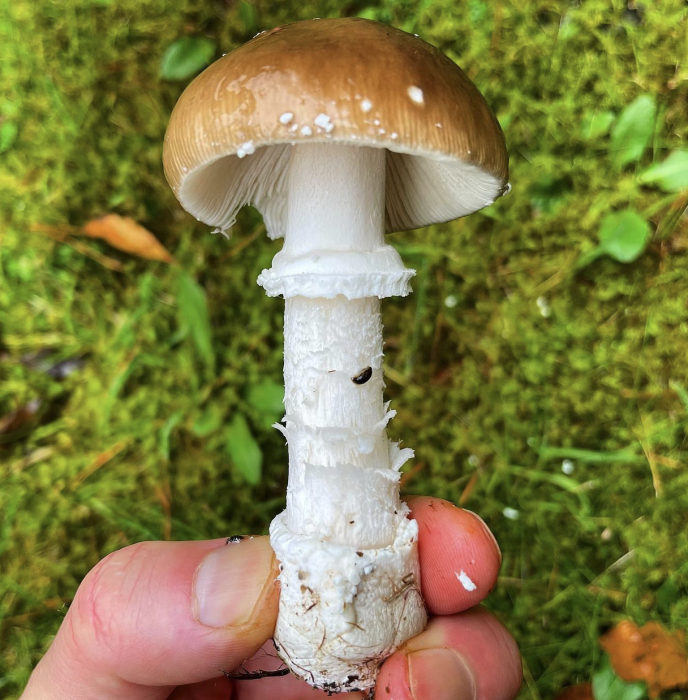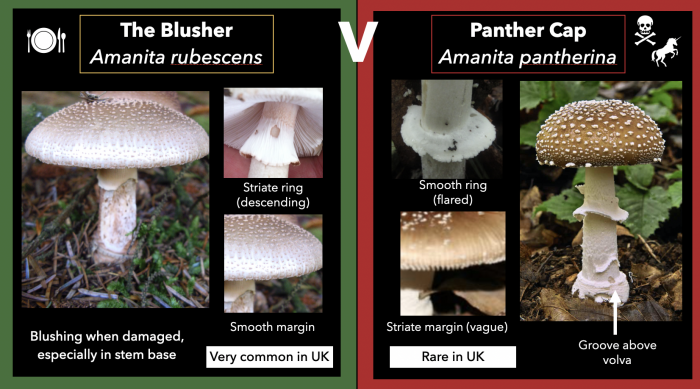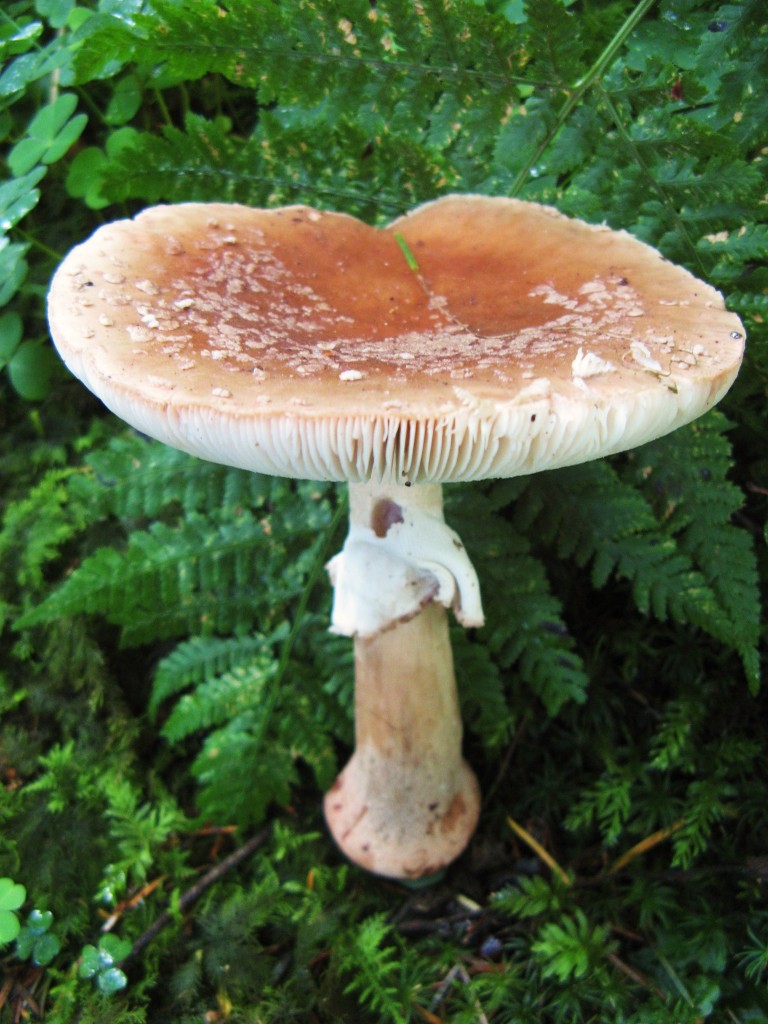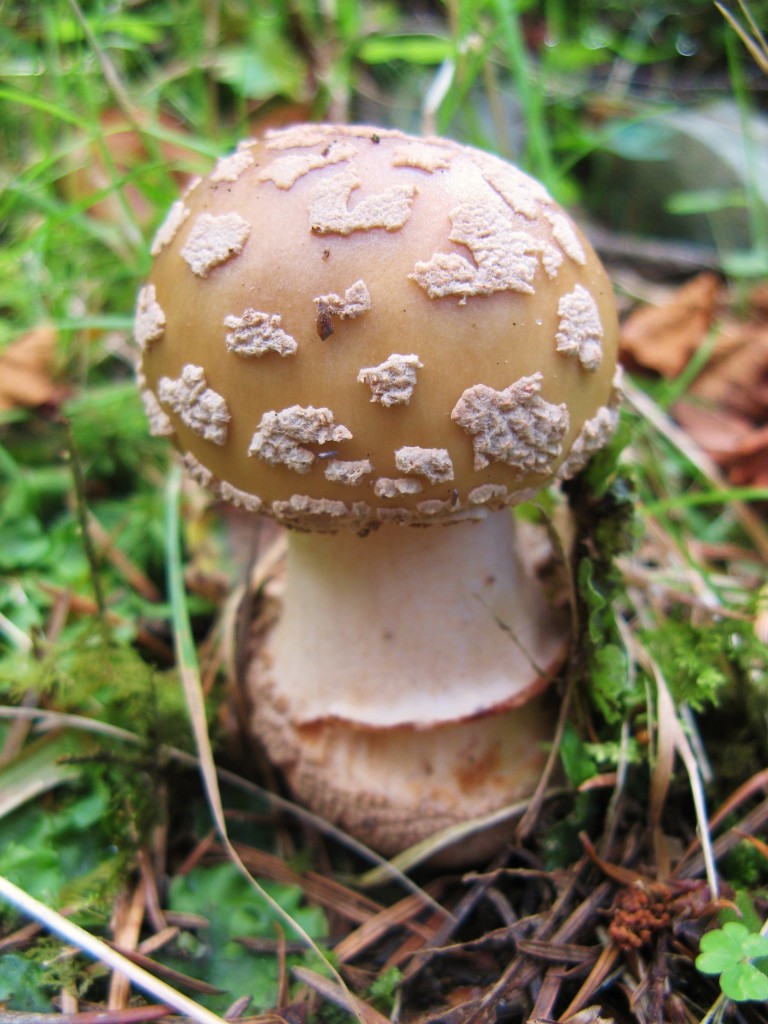The Blusher – Edibility, Identification, Distribution
Amanita rubescens
- Edibility – 3/5 – Must be cooked – can cause anemia if eaten raw. Standard advice is to chop, boil in salted water for up to 5 mins, discard water, rinse, then cook it as any other mushroom. A similar process can be used to detoxify its near relation the fly agaric, but this certainly does not work for its very poisonous cousins the death cap and destroying angel.
- Identification – 1/5 – Despite being very easy to find, the blusher is not a beginners mushroom – never munch on a hunch! Identification for the table requires close observation. Key features include a bulbous base, white ring on stipe, white gills that do not touch the stipe (free), and brown cap with white scales, but these are not enough to be sure you have a blusher. A tendency for its white flesh to bruise pinkish-red when damaged (it is loved by insect larvae so damage is common) should support your identification. Be sure you do not have a Panther Cap (Amanita pantherina) which has an ungrooved ring on the stipe, and a distinct rim (like an acorn cup) on its volva/base. The margin (cap edge) of blushers tend to be smooth, while the panther cap usually has fine striations. The cap of the panther cap tends to be more reliably deep brown, though cap colour in all fungi, and especially amanitas, can change rapidly according to weather condition and age. Despite being very easy to find, the blusher is not a beginners mushroom – never munch on a hunch!

Panther cap, Amanita pantherina. Note the fine striations on the cap edge, solid ring, and “guttering” around the top of the volva, which together should help distinguish it from the blusher. Note too that most of its scales have been washed off the cap, and there is no hint of blushing.
Image ©GallowayWildFoods.com
- Distribution – 5/5 – Very common indeed
- Season: June – November
- Habitat: most conifers and deciduous trees, but especially birch, beech, spruce and pine.
The blusher is one of the UK’s most common mushrooms, and certainly its most common edible fungi. Very few fungi forays fail to turn one up, usually dozens, often hundreds. So its something of a shame that its scary relatives (death cap, destroying angel, fly agaric, and especially panther cap, on account of it being a similar colour) mean it tends to be eaten only by confiden/experienced mycophagists.

How to tell a blusher from a panther cap. An image from my online webinar “20 Mushrooms to learn before you die“
I have seen hundreds of thousands of blushers over my 33 years of fungi foraging (mostly in W Scotland) but only found my first panther cap after 30 years – they are not common in Scotland, preferring calcarious soils. The fact that I walk past so many blushers without going into close ID mode, might mean i’ve missed some panther caps down the years. They are powerful hallucinogens, seemingly beyond even the fly agaric, and while they have been used in shamanic rituals, they can cause serious poisoning 9though not so life-threatening as death caps and destroying angel.
Another barrier to eating blushers is their extreme susceptibility to fungal gnat larvae infestation. Like ceps, they can be riddled with wrigglers before they are even close to fully formed.
But I still can’t help thinking we are mostly missing out on an excellent food source here…
Related Pages:


8 Comments
Are Blushers hallucinogenic?
No
Hi mark, is it ok to dry blushers and powder them without cooking?
Regards, Iain
I guess you would be cooking the powder anyway, when you come to use it? That is probably advisable anyway. Mark.
I am a bit confused regarding the edibility of A. rubescens. The local mycological society claims there is a difference between the specimens found in conifer woods as opposed to the ones found in deciduous/ broad leaf forests, and that they don’t recommend the conifer variety for the table. Yet, the reason why is not explained. I’m thinking because of toxins, but I can not find an iota of information on this subject anywhere else.
Hi Bork,
I’ve never heard this information before. Maybe ask them if they have a source for it? And I’d be grateful if you shared it here if they do!
Mark.
Thank you for your answer, I appreciate it. First of all, I must correct myself, as the source
of this information is indeed not the local mycological association, but from a site that
provides a so-called “AI” mushroom identification service. I have mailed them, asking
them for the source.
I have been in contact with a few experienced mushroom hunters and a couple
mycologists, and they have no references to the claims, and say that the current
consensus is that there is one European red-staining Amanita, A. rubescens, and
that it requires cooking for 10-15 minutes, regardless of its habitat.
I’ll await an eventual reply, and post the results here.
Hi Mark, I’m passionate about foraging, so you’re a man after my own heart. The Blusher is probably my favourite breakfast mushroom, due to its meaty texture – a perfect accompaniment to scrambled eggs and bacon! I always boil rapidly for 3 or 4 mins, then rinse well before patting dry and browning in a hot pan finished with butter. I always feel a bit guilty when collecting them though, because I usually use a paper bag to separate them from the ceps etc. – on account of their poisonous raw state – and thus prevent the dissemination of spores (though I would add that I don’t pick them often or in great numbers, and they’re locally prolific here in Fife).